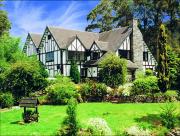Tasmania History and Heritage
Australia's second oldest settlement, Hobart was settled in Tasmania shortly after Sydney's establishment. Launceston was the third European settlement, but Tasmania's history pre-dates colonisation by thousands of years. Aboriginal people inhabited Tasmania during the last Ice Age, some 10,000 years ago, and their carvings and handprints in charcoal, blood and ochre can still be seen on cave walls.
Please visit these sites, but also respect them, as they are fragile and sacred to the Aboriginal people. Recommended places to visit include the Tiagarra Aboriginal Centre (Devonport), Rocky Cape (north west), Bedlam Walls (near Hobart), Wybalenna (Flinders Island) and Henty Dunes (West Coast).
Europeans first arrived in Tasmania in 1642 when a Dutch ship came across the island. First named Van Dieman's Land, French explorers soon followed (which explains the origin behind many of the French names used for bays, headlands and mountains across the island). The English arrived shortly after, settling with their boatloads of convicts and soldiers. It was these new arrivals who established the first farms and towns that now make up the Tasmania we know today.
Many stately homes and Georgian civic buildings recall the grand, bold visions of the early days, as well as the hand chiselled historic sites around Tasmania which remind us of the harsh convict period. The convict heritage is strongest on the Tasman Peninsula, particularly in Port Arthur and in towns like Richmond and Ross (the Female Factory and the hand-carved bridge), in the Old Hobart Gaol and on Maria Island where the penal settlement pre-dates the renowned Port Arthur site.
Tasmania also nurtures a strong mining heritage, enjoying abundant tin, gold, gemstones and copper. Queenstown still has some working mines (as the moonlike landscape attests) and visitors can pan for tin and other gems in Derby in the states northeast.


